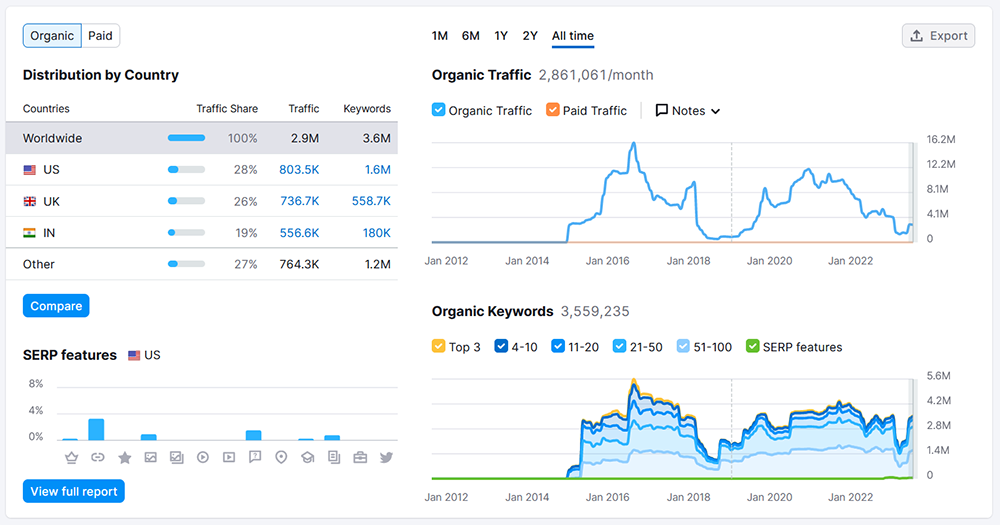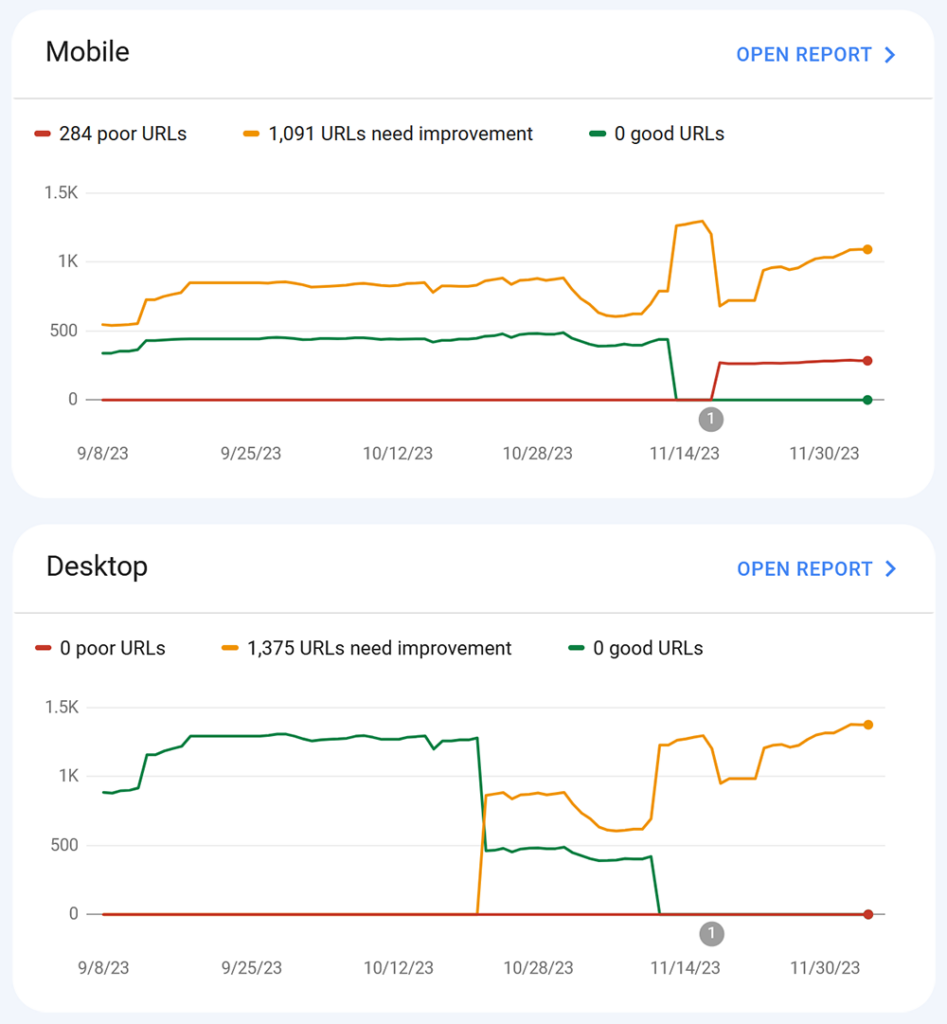Just like cleaning up after a big party with loads of house guests, recovering from a Google algorithm update takes a lot of work. Just imagine your website as the venue for one never-ending party. Every now and then Google reviews the experience it offers. Its (re)evaluation aims to ensure that people using Google search are directed to websites that offer the best experience.
It’s nothing personal.
So don’t take it the wrong way.
And don’t panic.
It All Comes Down to Keywords
You’ve managed to rank for some keywords, maintaining good positions for months or even years, only to eventually lose them.
Often, the scenario is that you quickly rank for high-volume keywords and maintain top positions for less than a year. This results in a sharp growth curve followed by an equally sharp drop.
A less common scenario is when a website has kept high search volume keyword positions on the first page for over a year.
In the first scenario, many webmasters are often left speechless having expected the sharp growth to continue, convinced it was due to their website’s quality.
Well, this is not the case.
When you start a content-rich website with a steady influx of new posts and pages, you often receive a significant initial boost from Google.
Think of this as a reward for sharing fresh content.
However, during this period, Google patiently collects data about your website from various sources, including your off-page SEO efforts.
Then comes the Core Update, and Google decides to assess and make some changes on page one.
This goes for well-established websites as well; although credibility is earned over a long period, these sites can also be hit hard.
In either scenario, you need to determine:
- Which keywords lost most traffic. Sometimes, a simple solution may be found by going through a technical SEO checklist and fixing bugs.
- The nature of keywords. Understanding the nature of keywords is crucial, as not all topics suit every website. For example, you wouldn’t want a car mechanic to fix your teeth; similarly, Google does not want unqualified individuals writing about serious topics like health and YMYL (Your Money or Your Life).

Five Step Recovery Plan
Recovering from a Google algorithm update isn’t a one-time fix.
Want to recover?
First, change how you think about SEO.
What you need is a holistic approach, which includes technical and on-page SEO, content auditing, trust signal improvement, and finally, using Google Search Console.
Sounds hard, but it’s really not.
So let’s start.
Read also: Site Audit Made Simple
1. Technical SEO Audit and Fixes
No matter the tools you use to analyse your website’s health, focus on:
- Dead Links: Find and fix them. Useful tool: Ahref’s SEO Site Audit tool
- Crawl Depth: Improve through enhanced menus and internal linking. Improve through better menus (consider introducing mega-menus) and internal linking. Useful tool: Screaming Frog.
- Image SEO: Optimize image size, scale, names, and alt texts. Useful tool: Adobe’s Free Image Resizer.
- Schema Markup: Remove duplicate Schema Markups and fix any errors. Useful tool: Schema Markup validator
2. On-Page Checks
Concentrate on:
- H1 to H3 tags: These are where you should include your keywords.
- SEO titles and meta descriptions: These should be in-sync with the contents of your pages.
3. Content Audit
You’ve just completed your website content, and you might wonder why further changes are necessary.
Well, they are.
Why?
Because your visitors will always crave a better experience.
Focus on:
- Keywords: If you sell ‘black gym leggings with pockets’, make sure to mention this in your title and description. But don’t repeat it excessively; nobody likes a spammer, including your customers and search engines.
- Rewrite Content: This might end up being the most time consuming job; but a full refresh can be especially helpful, as this way you are showing to Google that your content is worthy of a re-crawl.
- Spice Up Your Content: Include different formats like graphics, lists, tables, FAQs, and embedded videos. Don’t just rely on plain text – it’s no longer 2001.
Outdated Content: Remove any outdated content. If you still have content about how your company is dealing with Covid-19, it’s time to delete it.
4. Trust Signals
Trust signals are more than just links. They include reviews, citations, and entities, which also deserve your attention.
- Backlinks: Were those content farm links really necessary? Consider disavowing them.
- Reviews: Nowadays, reviews are arguably even more important than links.
- E-E-A-T (Experience, Expertise, Authority, and Trust): Complex concept to many, but it really shouldn’t be. Link your blog authors’ profiles to their LinkedIn or Twitter accounts and include a rel=’author’ tag.
5. Google Search Console is Your Best Friend
At first glance, Google Search Console doesn’t seem to show much data about your website, which is why many webmasters ignore it. However, consider two things: it’s owned by Google (where you aim to rank), and it selectively displays data. This should be a sign. Could it be that Google is really interested in how your website performs in these highlighted areas?
Address and optimise these aspects:
- Core Web Vitals: Switch to better hosting, resize and lazy-load images, and optimise the database. Useful tool: PageSpeed Insights.
- Crawl Errors: Fix crawl errors by implementing 301 redirects.

Final Thoughts
Don’t stress too much about the situation with your competitors, and don’t simply try to copy their solutions. Your most important task is to think about the people who will be browsing your website. Offer them something new, a reason to come, stay, and return to your website.
Need help? Contact us today and find out how we can help you recover from the lates Google Update.
- Outbound Links: Learn How They Help Your Website - August 19, 2024
- How to Build a WordPress Site with Multiple Languages - August 12, 2024
- Poorly Designed Websites Impact Rankings: Here’s Why - August 9, 2024